These are the kind of things I always picture when I think of "Celtic
Designs". It's kind of ironic, then, that these motifs appear rather late
in the history of Celtic art. As discussed in the
Knotwork Tutorial Introduction web page,
interlacing was probably adapted from northern European or Germanic sources.
Of course, the brilliant Insular artists itegrated it into the deep tradition
of Celtic art, and so made it (in some way) their own. Note that all source
documents are listed by author in square brackets, with the full name found
on the Class Bibliography page.
These images include both horizontal separator "lines" and vertical
backgrounds with left-hand borders. Please click on the bordered thumbnails
to see the full-size images.
Where possible, the components of the borders are provided. That is, the
left edge, the center (middle) repeated section, and the right edge are
provided as separate files. These may be combined to make borders of any size
desired.
These images are constructed such that they will "tile" evenly both across
and down a web page or Windows background. Some of these will work either as
web or Windows backgrounds, while others are too high contrast for web pages
where you need to be able to see the text on top of the background.
1. | |
2. | |
3. |
These tiles are the correct version of the pattern I first found
in [BainG] page 32, plate 7, page 53 Plate J, and [BainI] pg. 54. The original
source was the Book of Durrow folio 125V, and looks like:
 . It is interesting to
compare this to a design from the Durham Gospels, shown as:
Knotwork Tile 27, which looks
like: . It is interesting to
compare this to a design from the Durham Gospels, shown as:
Knotwork Tile 27, which looks
like:  . The tiles
in this set use the basic band treatment, "Kells" style bands, and doubled knotwork.
For details, see the Line Treatments section from
the knotwork tutorial pages. Tiles 3.h-o use a non-square (4:3 ratio) grid. The
tiles are rendered in shades of gray, "paint on vellum", "gold wire", and "carved
stone". . The tiles
in this set use the basic band treatment, "Kells" style bands, and doubled knotwork.
For details, see the Line Treatments section from
the knotwork tutorial pages. Tiles 3.h-o use a non-square (4:3 ratio) grid. The
tiles are rendered in shades of gray, "paint on vellum", "gold wire", and "carved
stone". |
a.  b.
b.  c.
c.  d.
d.  e.
e.  f.
f.  g.
g.  h.
h.  i.
i.  j.
j.  k.
k.  l.
l. 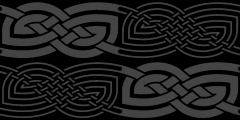 m.
m. 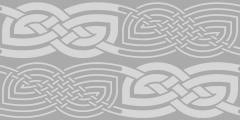 n.
n.  o.
o. 
| |
4. |
These tiles are based on a design pattern used in the Book of
Lindisfarne folio 27r, the Book of Kells folio 124r, and other places--
one of my favorites, as you can see from the large number of samples! The basic
pattern tile looks like:  . I tried to give the effect of "carved stone", "carved wood", "gold
wire/jewelry", "paint on paper", and simple gray-scale in these tiles. Band
styles include basic, wide, "Kells" style, and doubled. For details on band styles,
see the Line Treatments section from the knotwork
tutorial pages. . I tried to give the effect of "carved stone", "carved wood", "gold
wire/jewelry", "paint on paper", and simple gray-scale in these tiles. Band
styles include basic, wide, "Kells" style, and doubled. For details on band styles,
see the Line Treatments section from the knotwork
tutorial pages. |
a.  b.
b.  c.
c.  d.
d.  e.
e.  f.
f.  g.
g.  h.
h.  i.
i.  j.
j.  k.
k.  l.
l.  m.
m.  n.
n.  o.
o.  p.
p.  q.
q. 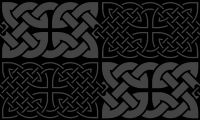 r.
r. 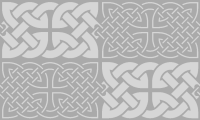 s.
s.  t.
t.  u.
u. 
| |
5. | |
6. | |
7. | |
8. | |
9. |
These tiles are based on a design from the front of the St. Vigean's
Stone number 1, Tayside (see [BainI] page 15 for a picture of the stone). The
basic pattern is:  ,
though some of the tiles below use a slightly simplified version which looks like: ,
though some of the tiles below use a slightly simplified version which looks like:
 . Tiles 9.a-d are
rendered in various "carved stone" textures, while 9.e, f, m and n are rendered in
"gold wire". Tiles 9.g, h, i, k, l, and o are done using simple dark and light
shades. Tile 9.j is intended to represent "embossed paper". Tiles 9.k, l, and o
use "doubled knotwork" bands and a space-filling pattern variant. Doubled
knotwork is discussed on the Line Treatments page
of the knotwork tutorial section. Tiles 9.m-o use a non-square, 4:3 ratio grid.
Non-square grids are covered in the Alternative Grids
section of the knotwork tutorial pages. . Tiles 9.a-d are
rendered in various "carved stone" textures, while 9.e, f, m and n are rendered in
"gold wire". Tiles 9.g, h, i, k, l, and o are done using simple dark and light
shades. Tile 9.j is intended to represent "embossed paper". Tiles 9.k, l, and o
use "doubled knotwork" bands and a space-filling pattern variant. Doubled
knotwork is discussed on the Line Treatments page
of the knotwork tutorial section. Tiles 9.m-o use a non-square, 4:3 ratio grid.
Non-square grids are covered in the Alternative Grids
section of the knotwork tutorial pages. |
a.  b.
b.  c.
c. 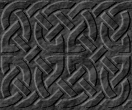 d.
d.  e.
e.  f.
f.  g.
g.  h.
h.  i.
i.  j.
j.  k.
k.  l.
l.  m.
m. 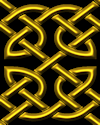 n.
n.  o.
o. 
| |
10. | |
11. | |
12. | |
13. |
The following are based on a pattern of interlocking loops sometimes
called the "Celtic Lover's Knot". Adrian Meehan in [Meehan2] calls this a "Josephine
Knot". It is also found on the Meigle Stone number 5 and also the Book of
Durrow Folio 8r, (see [BainI] page 104 and [Meehan2] page 36-42 for an analysis
of this pattern). I have transformed the basic CLK design (see the
Knotwork Border page, design 6, for the basic pattern,
which looks like:  ),
adapting it to make a space-filling repeating tile. Thanks to Kathy Marsten who
asked about the CLK design and caused me to research and develop the pattern! The
tiles are variously rendered in simple dark and light colors, "pressed paper",
"carved stone", painted vellum", and "gold wire/jewelry". Tiles 13.k, l, and n use
a "doubled knotwork" band pattern, which is described in the
Line Treatments section of the knotwork tutorial
pages. ),
adapting it to make a space-filling repeating tile. Thanks to Kathy Marsten who
asked about the CLK design and caused me to research and develop the pattern! The
tiles are variously rendered in simple dark and light colors, "pressed paper",
"carved stone", painted vellum", and "gold wire/jewelry". Tiles 13.k, l, and n use
a "doubled knotwork" band pattern, which is described in the
Line Treatments section of the knotwork tutorial
pages. |
a.  b.
b.  c.
c.  d.
d.  e.
e.  f.
f.  g.
g.  h.
h.  i.
i.  j.
j.  k.
k.  l.
l.  m.
m.  n.
n. 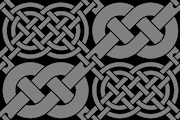
| |
14. | |
15. | |
16. | |
17. | |
18. | |
19. | |
20. | |
21. | |
22. |
This design is found in many original sources, including the Ardagh
Broach, the Monymusk Reliquary, and the Book of Lindisfarne Folio
13. I found references to this pattern in [BainG] page 36, and [Meehan2] page 106.
This is the simplest of what [Meehan2] refers to as "spiral knots", so it is also
related to Tiles 7 and 8 above. The underlying template for these looks like:
 . Tiles 22.a-d and
22.g-j are rendered using shades of gray. Tiles 22.c, d, i and j use a doubled
version of the basic pattern. Doubled knotwork is discussed on the
Line Treatments page of the knotwork tutorial
section. Tile 22.e-f, k, and l are rendered as "gold wire/jewelry" in reference
to their original origins, with Tile 22.k attempting to replicate the exact look of
the brooch. Tiles 22.g-h use a single-double combination style. . Tiles 22.a-d and
22.g-j are rendered using shades of gray. Tiles 22.c, d, i and j use a doubled
version of the basic pattern. Doubled knotwork is discussed on the
Line Treatments page of the knotwork tutorial
section. Tile 22.e-f, k, and l are rendered as "gold wire/jewelry" in reference
to their original origins, with Tile 22.k attempting to replicate the exact look of
the brooch. Tiles 22.g-h use a single-double combination style. |
a.  b.
b.  c.
c.  d.
d.  e.
e.  f.
f.  g.
g. 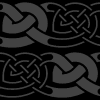 h.
h. 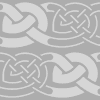 i.
i.  j.
j.  k.
k.  l.
l. 
| |
23. | |
24. | |
25. |
The following pattern is found in a number of original sources, including
the Book of Lindisfarne Folio 95 (and others), the Book of Kells
Folios 3R and 4R, and St. Chad's Gospels Folio 221. The Lindisfarne
original used a doubled band, and was colored yellow/red on black. Doubled knotwork
is discussed on the Line Treatments page of the
knotwork tutorial section. There are two slight pattern variations; one that simply
repeats the following motif:  , and one that repeats and inverts part of the basic pattern, which forms
the following repeating tile: , and one that repeats and inverts part of the basic pattern, which forms
the following repeating tile:  . The clip-art tiles in this series use both variations of the basic
template, as well some that "stack" two inverted variations to make a more complex
pattern when tiled accross a page/window (see tiles 25.e, j, and k). Tiles are done
in shades of gray, "paint on parchment" and "gold wire". . The clip-art tiles in this series use both variations of the basic
template, as well some that "stack" two inverted variations to make a more complex
pattern when tiled accross a page/window (see tiles 25.e, j, and k). Tiles are done
in shades of gray, "paint on parchment" and "gold wire". |
a.  b.
b.  c.
c.  d.
d.  e.
e.  f.
f.  g.
g.  h.
h.  i.
i.  j.
j.  k.
k.  l.
l.  m.
m.  n.
n. 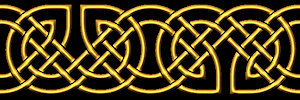 o.
o.  p.
p.  q.
q. 
| |
26. |
Tile 26 uses a pattern from the Book of Lindisfarne, folios 94B and
95. It is also found in the Book of Durrow, and probably others. It can be
found pre-analyzed in [BainI] pages 21 and 101. The basic tile pattern looks like:
 . The tiles are
rendered in shades of gray, "paint on parchment", and "gold wire". Tiles 26.c, d, i,
j, and l all use doubled knotwork bands, as did the original. Doubled knotwork is
discussed on the Line Treatments page of the
knotwork tutorial section. Tile 26.l was constructed on a non-square grid (4:3
ratio rather than 1:1, or square). For instruction on how to build knots using
non-square grids, see the Alternative Grids section
from the knotwork tutorial pages. . The tiles are
rendered in shades of gray, "paint on parchment", and "gold wire". Tiles 26.c, d, i,
j, and l all use doubled knotwork bands, as did the original. Doubled knotwork is
discussed on the Line Treatments page of the
knotwork tutorial section. Tile 26.l was constructed on a non-square grid (4:3
ratio rather than 1:1, or square). For instruction on how to build knots using
non-square grids, see the Alternative Grids section
from the knotwork tutorial pages. |
a.  b.
b.  c.
c.  d.
d.  e.
e.  e.
e.  g.
g.  h.
h.  i.
i.  j.
j.  k.
k.  l.
l. 
| |
27. | |
28. | |
29. | |
30. | |
31. |
These tiles were taken from a pattern found on the Great Wheel-Cross
of Corbelin, Margam Abbey, Glamorganshire. I found it pictured in [Allen], pg.
187. It is kind of a "Celtic Lover's Knot" pattern (see Tile 13 above) on it's side
(especially in the space filling variation), or a "Kells 124R" pattern (see Tile 20
above) with extra "walls" in the underlying cell template. The basic pattern looks
like:  . The tiles below
show the basic pattern modified to be space-filling, rendered in shades of gray
(31.a, b, d, e), "paint on vellum" (31.c), and "carved rock" (31.f). Tiles 31.d and
e use a doubled knotwork treatment. For details on doubled knotwork and other band
treatments, please see the Line Treatments section
rom the knotwork tutorial pages. . The tiles below
show the basic pattern modified to be space-filling, rendered in shades of gray
(31.a, b, d, e), "paint on vellum" (31.c), and "carved rock" (31.f). Tiles 31.d and
e use a doubled knotwork treatment. For details on doubled knotwork and other band
treatments, please see the Line Treatments section
rom the knotwork tutorial pages. |
a.  b.
b.  c.
c.  d.
d.  e.
e.  f.
f. 
| |
32. | |
33. |
This interesting pattern is based on one from the front of the carved
Alskog Stone, Gotland (Sweden). I found it in [BianI] page 108, where it is
also referred to as a “doubled Stafford knot”. The basic cell template is also
used on the Maiden Stone tiles (see Tile 18 above); the Alskog
version is the Viking form with rounded off band corners. Tile 33.c uses a
combination of single and doubled knotwork, in shades of gray. For details on
constructing doubled knotwork and other band treatments, please see the
Line Treatments section from the knotwork tutorial
pages. |
a.  b.
b.  c.
c. 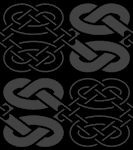
| |
34. | |
35. |
These tiles were developed as part of some research I've been doing on the
influence of Northern European/Insular Celtic art on Central Asian art. The original
pattern was taken from what I've called the David Lampas Silk, a fragment of a
lampas textile (considered a luxury fabric, woven in silk with supplementary patterns
laid on top, 36x53cm) in the David Collection, Copenhagen, Inv. 2/1989. The artifact
image was provided to me by the art historians of the Art and Science Endowment Trust
(ASET) in Berlin, Germany. I developed the underlying cell pattern using the
techniques found in the Knotwork Analysis tutorial page.
The tiles use both simple gray-scale schemes and an attempt at duplicating the
original textile colors. |
a.  b.
b.  c.
c. 
| |
36. | |
37. |
This is another pattern I analyzed as part of some research I've been doing
on the influence of Northern European/Insular Celtic art on Central Asian art. This
one was taken from the Topkapi Museum Library Frontispiece, the frontispiece
of a Qurân written on vellum ascribed to the 13th Century CE. It is now residing in
the Topkapi Museum Library, Istanbul (E.H. 219, f.1v). The artifact image was
provided to me by the art historians of the Art and Science Endowment Trust (ASET),
Berlin, Germany. I developed the underlying cell pattern using the techniques found
in the Knotwork Analysis tutorial page. The underlying
cell template bears a resemblance to the pattern in Tile 36 above, and the pattern
was pretty obviously drawn using the same techniques covered in the
Knotwork Tutorial. Interesting, right? The tiles use
both simple gray-scale and a color scheme matching the original frontispiece. |
a.  b.
b.  c.
c. 
| |
38. | |
39. | |
40. | |
41. |
|
42. | |
43. | |
44. |
This sinuous design was found on “Viking Age knotwork borders”, URL:
spirit-of-the-past.com (site appears to be defunct, alas). The cell template is
closely related to Tile 8 above. I reverse-engineered the cell template
using the techniques found in the Knotwork Analysis
tutorial page. The tiles use simple gray-scale color schemes and as a "carved
stone" texture. |
a.  b.
b.  c.
c. 
| |

